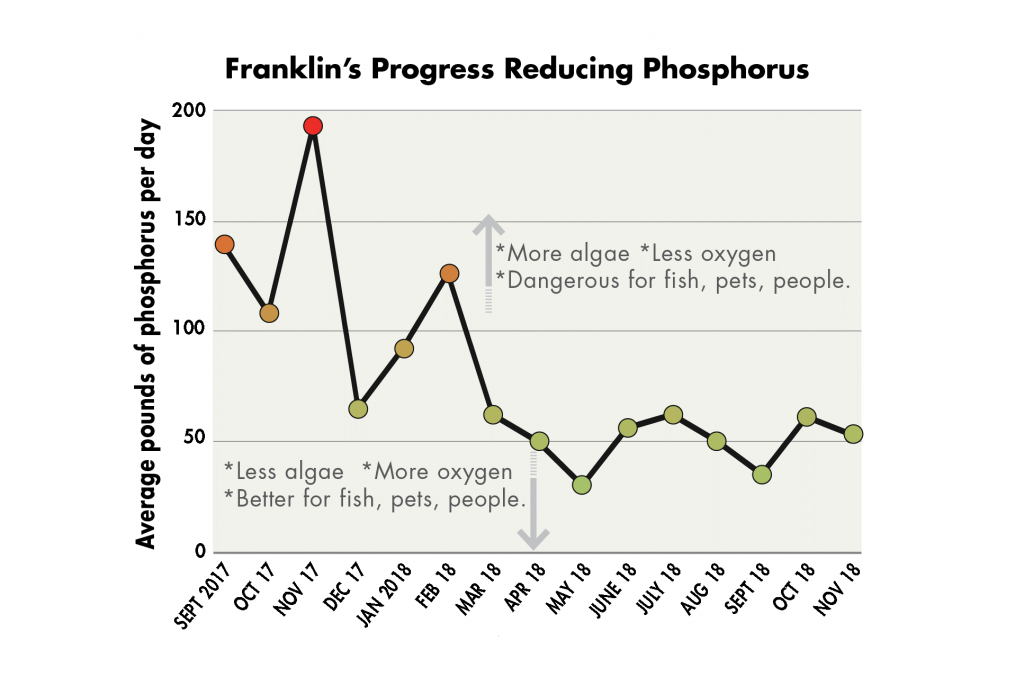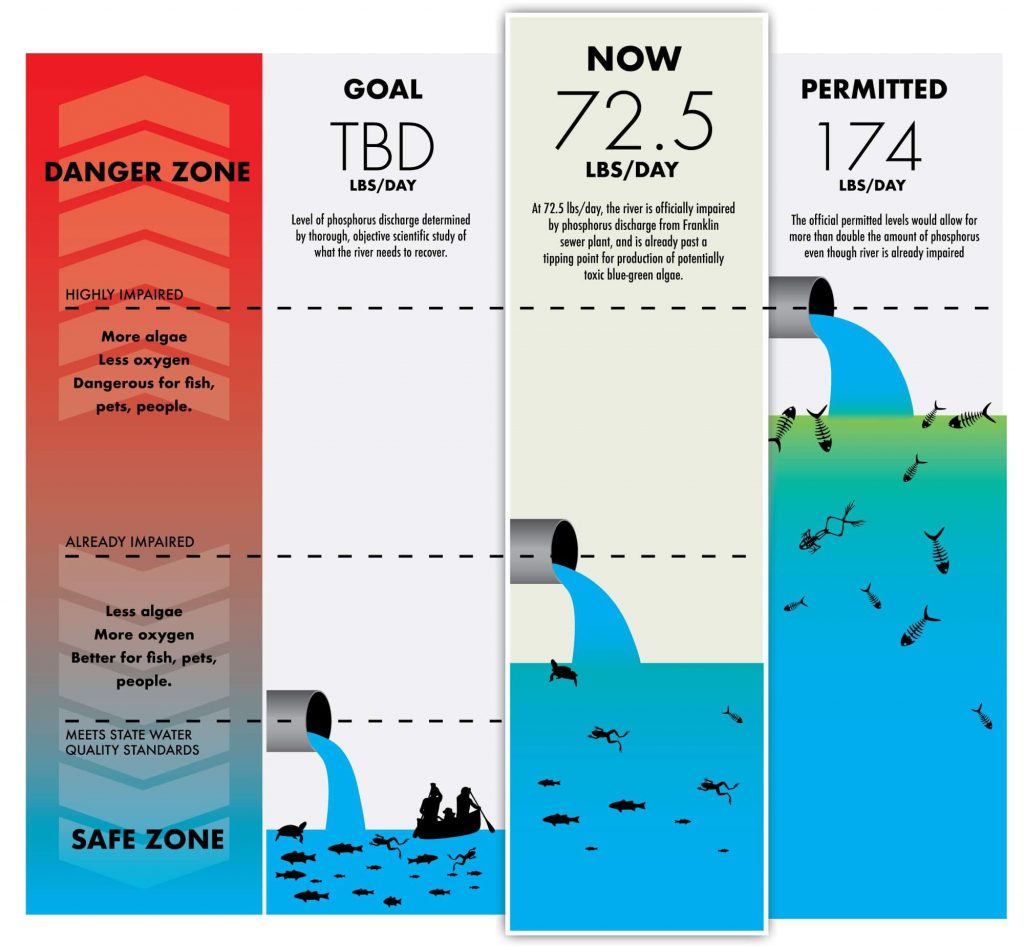Harpeth Conservancy Launches New Water Reporter Initiative
FOR IMMEDIATE RELEASE (March 06, 2018) Harpeth Conservancy Launches New Water Reporter Initiative Harpeth Conservancy is holding the first training session for its new citizen
High levels of nutrients like phosphorus are a problem for water quality and public health. Too much phosphorus can cause algal blooms, including toxic blue-green algae, which can cause health and environmental problems. CLICK HERE to learn more about the potential dangers of algal blooms.
National experts say current conditions on the Harpeth River are already past the tipping point for production of potentially toxic blue-green algae. We raised these issues, along with a number of other legal obligations applicable to the sewer plant, in our comments on the permit that TDEC issued in 2017.

As a result of your efforts, Franklin’s sewer permit now contains an action level that requires Franklin to report to TDEC When its total monthly phosphorus discharge is greater than an average level of 1.3 mg/L during that month. When Franklin exceeds that action level, it must report to TDEC and analyze and refine its operations to reduce total phosphorus levels to below the action level, but without expending significant capital. The permit also now requires Franklin to submit an annual report on its efforts to optimize its plant to reduce nutrient pollution.
Franklin exceeded its action level in January 2018. However, we are pleased to report that Franklin has now started the analysis and plant optimization efforts required by the permit. Franklin’s results are encouraging, and we commend them and encourage the City to continue to improve even more!

For many years, the Harpeth Conservancy has been concerned that the Franklin sewage treatment plant was not being operated as efficiently as it could be or in compliance with legal requirements. In 2014 the Harpeth Conservancy was forced to file a citizen suit under the federal Clean Water Act when Franklin rebuffed attempts to resolve issues amicably (citizen suit available HERE). The Harpeth Conservancy raised a number of issues in that action, including repeated sewer overflows and Franklin’s failure to submit a nutrient optimization report as required by the discharge permit for the plant. We successfully settled that case, resulting in a number of improvements in the operations of the Franklin sewer plant.
On June 1, 2017, TDEC issued to Franklin the permit for the City’s sewer plant (permit available HERE). The fundamental problem in the permit issued by TDEC was that it failed to recognize that the Harpeth River is impaired by phosphorus pollution (and violates State water quality standards for dissolved oxygen) and is on the State’s 303(d) list.
The Harpeth River is impaired for phosphorus downstream of the City of Franklin where the Franklin sewer plant is located. For another almost 50 river miles River is also below water quality standards.
According to TDEC’s 303(d) list, a biennial report of waters that are “impaired” and don’t meet the water quality standards TDEC itself sets, the cause of the phosphorus pollution is Franklin’s sewage treatment plant (and Franklin’s stormwater systems). To read the State’s 303(d) list, click here.
Franklin’s own monitoring data show that just one (1) river mile downstream from the plant, from 2002 to 2014, 73% of the load of total phosphorus in the Harpeth, and 50% of the river’s load of total nitrogen, are from the Franklin sewer plant when effluent is 15% or more of the river’s flow. During October 2016, the last drought period, the daily average amount of treated sewage effluent just one (1) river mile downstream from the plant was 55% of the entire river’s flow.
Over the period of 2012 to 2017, Franklin’s sewer plant discharged approximately 72 pounds of phosphorus per day in 2018. At this level, the Harpeth River is impaired by phosphorus pollution. The 2017 permit allowed Franklin to discharge more than double the amount of phosphorus it was actually discharging. The permit allowed Franklin to discharge 174.5 pounds of phosphorus per day. By comparison, Georgia and Virginia have achieved phosphorus outputs of 8 to 13 pounds per day.

This was one of the primary reasons the Harpeth Conservancy filed an appeal of the permit. Learn more about the Harpeth Conservancy’s permit appeal here.
Franklin also appealed its own permit, claiming either that no phosphorus limit is necessary, or that it should be allowed to discharge even more phosphorus! To read Franklin’s permit appeal in its entirety, click here.
Based on progress to date, Harpeth Conservancy and Franklin are dismissing their permit appeals. Harpeth Conservancy initiated this process by leverage of Franklin and TDEC. A copy of Harpeth Conservancy’s letter can be found here. To read Harpeth Conservancy’s press release on the permit dismissal click here.
Although the Harpeth River is still impaired by phosphorus, Franklin has made progress in reducing its phosphorus output. We will continue efforts to improve the conditions in the river, and in the surrounding areas that affect the river’s water quality. In 2017, Franklin spent roughly $25,000 in public money to commission a study to say that it could not optimize the sewage plant for phosphorus reduction. Franklin’s positive efforts have since proved that study wrong.
The Harpeth Conservancy will also continue to participate in the pollution reduction study and plan called a Total Maximum Daily Load (“TMDL”). A TMDL is a plan for restoring a polluted water body that identifies the maximum amount of a pollutant the water can receive while still meeting applicable state water quality standards. CLICK HERE to learn more about the Harpeth River TMDL and how the Harpeth River is pushing for a science-driven, transparent, speedy process to put the river on the path to restoration!
FOR IMMEDIATE RELEASE (March 06, 2018) Harpeth Conservancy Launches New Water Reporter Initiative Harpeth Conservancy is holding the first training session for its new citizen
Franklin—May 10, 2016 The City of Franklin and the conservation organization, Harpeth River Watershed Association (HRWA), have resolved their differences regarding the City’s operation of
© 2019 Harpeth Conservancy. All rights reserved.